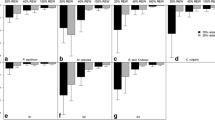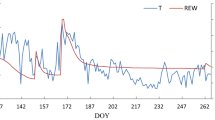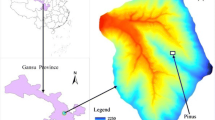Abstract
Caragana korshinskii is widely used in vegetation reestablishment programs to stabilize the shifting of sand on the Loess Plateau. This sand shifting of sand exerts pressure on the limited soil water and vice versa. However, detailed transpiration and sap flow studies that focus on water use in these stands remain limited. The hourly sap flows, along with successive soil water balance and meteorological measurements, on three trees were measured using the thermal heat balance method during the growing season period. Results showed that the midday sap flow and stand transpiration were significantly lower during the stress period (from May to July) compared with those at the beginning of August concurrently with high soil water content. The heat balance measurements underestimated the transpiration obtained from the soil water balance method. When the tree conductance was fitted with climatic variables and soil water content, the canopy conductance increased exponentially with above-canopy radiation, whereas it decreased logarithmically with decreasing vapor pressure deficit. In the absence of water stress, the tree conductance was unchanged when the relative extractable water remained above 0.4, whereas the conductance decreased linearly after the wilting point. The model was generally well fitted to the measured transpiration data in terms of the response during the dry and rainy seasons, thus demonstrating the feasibility of developing a quantity schedule for C. korshinskii transpiration on the Loess Plateau in the presence of a soil water stress.






Similar content being viewed by others
References
Barradas VL, Nicolás E, Torrecillas A, Alarcón JJ (2005) Transpiration and canopy conductance in young apricot (Prunus armenica L.) trees subjected to different PAR levels and water stress. Agric Water Manag 77:323–333
Bosch JM, Hewlett JD (1982) A review of catchment experiments to determine the effect of vegetation changes on water yield and evapotranspiration. J Hydrol 55:3–23
Cao CY, Jiang DM, Luo YM, Kou ZW (2000) Ecological process of vegetation restoration in Caragana microphylla sand-fixing area. Chin J Appl Ecol 11:349–354
Chabot R, Bouarfa S, Zimmer D, Chaumont C, Duprez C (2002) Sugarcane transpiration with shallow water-table: sap flow measurements and modelling. Agric Water Manag 54:17–36
Chaves MM, Flexas J, Pinheiro C (2009) Photosynthesis under drought and salt stress: regulation mechanisms from whole plant to cell. Ann Bot 103:551–560
Chen L, Wei W, Fu B (2007) Soil and water conservation on the Loess Plateau in China: review and perspective. Prog Phys Geogr 31:389–403
Cheng XR, Huang MB, Shao MA (2006) Vertical distribution of representative plantation’s fine root in wind-water erosion crisscross region, Shenmu. Acta Bot Boreal Occident Sin 27:321–327 (in Chinese with English abstract)
Cheng X, Huang M, Shao M, Warrington DN (2009) A comparison of fine root distribution and water consumption of mature Caragana korshinkii Kom grown in two soils in a semiarid region, China. Plant Soil 315:149–161
Chirino E, Bellot J, Sánchez JR (2011) Daily sap flow rate as an indicator of drought avoidance mechanisms in five Mediterranean perennial species in semi-arid southeastern Spain. Trees Struct Funct 25:593–606
Cienciala E, Lindroth A, Cermak J, Hallgren JE, Kucera J (1994) The effects of water availability on transpiration, water potential and growth of Picea abies during a growing season. J Hydrol 155:57–71
Cienciala E, Kucera J, Ryan MG, Lindroth A (1998) Water flux in boreal forest during two hydrologically contrasting years species specific regulation of canopy conductance and transpiration. Ann Sci For 55:47–61
Clausnitzer F, Köstnera B, Schwärzelb K, Bernhofer C (2011) Relationships between canopy transpiration, atmospheric conditions and soil water availability––analyses of long-term sap-flow measurements in an old Norway spruce forest at the Ore mountains/Germany. Agric For Meteorol 151:1023–1034
Fang XW, Wang XZ, Chen K, Li H, Wang G (2006) Responses of Caragana korshinskii to different aboveground partial shoot removal: combining defense and tolerance strategies. Ann Bot 98:203–211
Gardiol JM, Leonardo AS, Aida IDM (2003) Modelling evapotranspiration of corn (Zea mays) under different plant densities. J Hydrol 271:291–308
GISLP (Group for Integrated Survey of the Loess Plateau) (1991) Land resource of the Loess Plateau. China Science and Technology Press, Beijing, p 355
Granier A, Loustau D (2000) A generic model of forest canopy conductance dependent on climate, soil water availability and leaf area index. Ann For Sci 57:755–765
Granier A, Biron P, Lemoine D (2000) Water balance, transpiration and canopy conductance in two beech stands. Agric For Meteorol 100:291–308
He XB, Li ZB, Hao MD, Tang KL, Zheng FL (2003) Down-scale analysis for water scarcity in response to soil-water conservation on Loess Plateau of China. Agric Ecosyst Environ 94:355–361
Irannejad P, Shao Y (1998) Description and validation of the atmosphere-land-surface interaction scheme (ALSIS) with HAPEX and Cabauw data. Global Plan 19:87–114
Jarvis PG (1976) The interpretation of the variation in leaf water potential and stomatal conductance found in canopies in the field. Philos Trans R Soc Lond 273:596–610
Jarvis PG, McNaughton KG (1986) Stomatal control of transpiration: scaling up from leaf to region. Adv Ecol Res 15:1–49
Kaufmann MR (1982) Leaf conductance as a function of photosynthetic photon flux density and absolute humidity difference from leaf to air. Plant Physiol 69:1018–1022
Kume T, Takizawa H, Yoshifuji N, Tanaka K, Tantasirin C, Tanaka N, Suzuki M (2007) Impact of soil drought on sap flow and water status of evergreen trees in a tropical monsoon forest in northern Thailand. For Ecol Manag 238:220–230
Lagergren F, Lindroth A (2002) Transpiration response to soil moisture in pine and spruce trees in Sweden. Agric For Meteorol 112:67–85
Li SB, Wang B, Bai YQ, Wang L (2000) Studies on the characteristics of the main forage shrub species in Yanchi sandy land. Sci Sil Sin 36:119–125
Lu P, Biron P, Breda N, Granier A (1995) Water relations of adult Norway spruce (Picea abies (L.) Karst) under soil drought in the Vosges mountains: water potential, stomatal conductance and transpiration. Ann For Sci 52:117–129
Ma CC, Gao YB, Liu HF, Wang JL, Guo HY (2003) Interspecific transition among Caragana microphylla, C. davazamcii and C. korshinskii along geographic gradient. I Ecological and RAPD evidence. Acta Bot Sin 45:1218–1227
Mahieu S, Germon F, Aveline A, Hauggaard-Nielsen H, Ambus P, Jensen ES (2009) The influence of water stress on biomass and N accumulation, N partitioning between above and below ground parts and on N rhizodeposition during reproductive growth of pea (Pisum sativum L.). Soil Biol Biochem 41:380–387
Martin TA, Brown KJ, Cermak J, Ceulemans R, Kucera J, Meinzer FC, Rombold JS, Sprugel DG, Hinckley TM (1997) Crown conductance and tree and stand transpiration in a second-growth Abies Amabilis forest. Can J For Res 27:797–808
McLaughlin DL, Brown MT, Cohen MJ (2011) The ecohydrology of a pioneer wetland species and a drastically altered landscape. Ecohydrology 5:656–667
Monteith JL (1965) Evaporation and environment. Symp Soc Exp Biol 19:205–234
Parton WA, Mosier D, Ojima D, Valentine D, Schimel K, Weier AK (1996) Generalized model for N2 and N2O production from nitrification and denitrification. Glob Biogeochem Cycl 10:401–412
Rana G, Katerji N, de Lorenzi F (2005) Measurement and modelling of evapotranspiration of irrigated citrus orchard under Mediterranean conditions. Agric For Meteorol 128:199–209
Rodriguez-Iturbe I, Porporato A, Laio F, Ridolfi L (2001) Plants in water-controlled ecosystems: active role in hydrologic processes and response to water stress: I. Scope and general outline. Adv Water Res 24:695
Rutter AJ (1967) Studies of the water relations of Pinus sylvestris in plantation conditions. Part V. Responses to variation in soil water conditions. J Appl Ecol 4:73–81
Shao MA (2001) Ecological construction in the Chinese Loess Plateau. Shaanxi Science Press, Xi’an
Shao HB, Chu LY, Jaleel CA, Manivannan P, Panneerselvam R, Shao MA (2009) Understanding water deficit stress-induced changes in the basic metabolism of higher plants-biotechnologically and sustainably improving agriculture and the ecoenvironment in arid regions of the globe. Crit Rev Biotechnol 29:131–151
Si JH, Feng Q, Zhang XY, Chang ZQ, Su YH, Xi HY (2007) Sap flow of populus euphratica in a desert riparian forest in an extreme arid region during the growing season. J Integr Plant Biol 49:425–436
Sommer R, de Abreu Sá TD, Vielhauer K, de Araújo AC, Fölster H, Vlek PLG (2002) Transpiration and canopy conductance of secondary vegetation in the eastern Amazon. Agric For Meteorol 112:103–121
Steinberg SL, van Bavel CHM, McFarland MJ (1990) Improved sap-flow gauge for woody and herbaceous plants. J Agron 82:851–854
Stewart JB (1988) Modelling surface conductance of pine forests. Agric For Meteorol 43:19–35
Thom AS, Oliver HR (1977) On Penman’s equation for estimating regional evaporation. Q J R Meteorol Soc 103:345–357
Vörösmarty CJ, Moore IB, Grace AL, Gildea MP, Melillo JM, Peterson BJ, Rastetter B, Steudler PA (1989) Continental scale models of water balance and fluvial transport: an application to South America. Glob Biogeochem Cycl 3:241–265
Wang T (2000) Land use and sandy desertification in north China. J Desert Res 20:103–108
Wang YQ, Shao MA, Shao HB (2010) A preliminary investigation of the dynamic characteristics of dried soil layers on the Loess Plateau of China. J Hydrol 381:9–17
Whitley R, Medlyn B, Zeppel M, Macinnis-Ng C, Eamus D (2009) Comparing the Penman-Monteith equation and a modified Jarvis-Stewart model with an artificial neural network to estimate stand-scale transpiration and canopy conductance. J Hydrol 373:256–266
Xia YQ, Shao MA (2008) Soil water carrying capacity for vegetation: a hydrologic and biogeochemical process model solution. Ecol Model 214:112–124
Xia G, Kang S, Li F, Zhang J, Zhou Q (2007) Diurnal and seasonal variations of sap flow of Caragana korshinskii in the arid desert region of north-west China. Hydrol Process 22:1197–1205
Yue G, Zhao H, Zhang T, Zhao X, Niu L, Drake S (2008) Evaluation of water use of Caragana microphylla with the stem heat-balance method in Horqin Sandy Land, Inner Mongolia, China. Agric For Meteorol 148:1668–1678
Zhou GY, Huang ZH, Jim M, Li ZA, John C, Zhang NN, Bai JY (2002) Radial variation in Sap flux density as a function of Sapwood thickness in two eucalyptus (Eucalyptus urophylla) plantations. J Integr Plant Biol 44:1418–1424
Zhou HY, Li XR, Fan HW, Wang XP, Tan HJ, Li AX (2005) Physiological characteristics of several Caragana shrub species under extreme conditions. J Des Res 25:182–190
Zhu Z, Wang T (1993) Trends in desertification and its rehabilitation in China. Desertif Control Bull 22:27–30
Zweifel R, Häsler R (2001) Dynamics of water storage in mature subalpine Picea abies: temporal and spatial patterns of change in stem radius. Tree Physiol 21:561–569
Acknowledgments
We acknowledge the financial support provided by the National Nature Science Foundation of China through grants No. 51109063, the China Postdoctoral Science Foundation (2011M500115, 2012T50433), and the Priority Academic Program Development of Jiangsu Higher Education Institutions (PAPD).
Author information
Authors and Affiliations
Corresponding author
Rights and permissions
About this article
Cite this article
She, D., Xia, Y., Shao, M. et al. Transpiration and canopy conductance of Caragana korshinskii trees in response to soil moisture in sand land of China. Agroforest Syst 87, 667–678 (2013). https://doi.org/10.1007/s10457-012-9587-4
Received:
Accepted:
Published:
Issue Date:
DOI: https://doi.org/10.1007/s10457-012-9587-4




